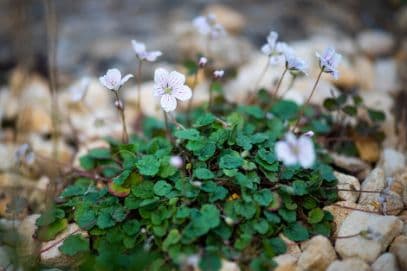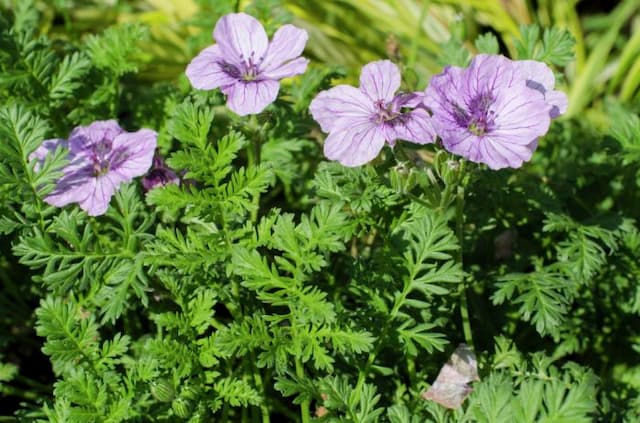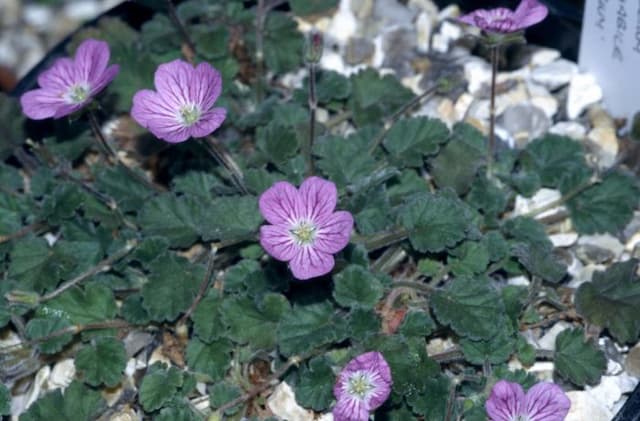Wild Geranium Geranium maculatum 'Espresso'

ABOUT
The Geranium maculatum 'Espresso', commonly known as wild geranium or spotted geranium, is distinguished by its unique, deeply lobed foliage. The leaves are a notable feature, presenting a rich, chocolate-coffee shade that remains consistent as the seasons progress. This dark foliage sets an exquisite backdrop that contrasts with the plant's flowers. Wild geranium blooms with pale lavender to pink flowers that have five rounded petals, adding a soft splash of color in contrast with the dark leaves. Each flower is marked by delicate veining which can be more pronounced in some blossoms. The veining, coupled with the flower's symmetry, makes them particularly eye-catching. The plant possesses a bushy growth habit with the foliage bunching together, giving it a dense, lush appearance. Its stems rise above the foliage and support the blooms in clusters, which only adds to its ornamental appeal. When not in bloom, wild geranium's foliage maintains visual interest in the garden due to its deep hue and textured surface. The combination of dark foliage and pastel flowers makes this particular variety of wild geranium an attractive choice for gardeners looking to create a striking contrast in the landscape.
About this plant
 Names
NamesFamily
Geraniaceae
Synonyms
Wild Geranium, Spotted Geranium, Cranesbill, Wood Geranium
Common names
Geranium maculatum 'Espresso'.
 Toxicity
ToxicityTo humans
The wild geranium, to which Geranium maculatum 'Espresso' belongs, is considered non-toxic to humans. Therefore, ingesting parts of this plant typically does not lead to poisoning or adverse health effects.
To pets
The wild geranium, to which Geranium maculatum 'Espresso' belongs, is also generally considered non-toxic to pets, including cats and dogs. Ingesting parts of this plant is not expected to cause poisoning or serious health issues in pets. However, individual animals might have sensitivities, and ingestion can sometimes lead to mild gastrointestinal upset.
 Characteristics
CharacteristicsLife cycle
Perennials
Foliage type
Deciduous
Color of leaves
Purple-green
Flower color
Lavender-pink
Height
1-2 feet (30-60 cm)
Spread
1-1.5 feet (30-45 cm)
Plant type
Herb
Hardiness zones
3-8
Native area
North America
Benefits
 General Benefits
General Benefits- Attractive Foliage: The 'Espresso' variant of Wild Geranium has dark, coffee-colored leaves that add a unique aesthetic to gardens.
- Flower Display: It produces lovely pink to lilac flowers in spring which enhance the visual appeal of outdoor spaces.
- Wildlife Attraction: The flowers attract pollinators like bees and butterflies, supporting local ecosystems.
- Low Maintenance: Once established, Wild Geranium is drought-tolerant and requires minimal care.
- Shade Tolerance: It can thrive in partially shaded areas where other plants may not grow well.
- Naturalization: Wild Geranium can spread and naturalize in an area, filling out garden beds and spaces with its foliage and flowers.
- Seasonal Interest: Provides visual interest in spring and early summer and has foliage that changes color in the fall.
- Erosion Control: Its root system can help stabilize soil and control erosion, especially in shaded or woodland areas.
 Medical Properties
Medical Properties- Anti-diarrheal: Traditionally used to help reduce diarrhea due to its astringent properties.
- Astringent: Can be applied topically to help tighten and tone skin or mucous membranes, reduce minor bleeding.
- Mouthwash Ingredient: Sometimes used as a component in mouthwashes for its astringent effects on the gums.
- Anti-inflammatory: Contains compounds that may offer mild anti-inflammatory benefits.
- Sore Throat Remedy: Employed as a gargle or throat rinse to soothe sore throats.
 Air-purifying Qualities
Air-purifying QualitiesThis plant is not specifically known for air purifying qualities.
 Other Uses
Other Uses- As a natural dye: The Geranium maculatum 'Espresso', commonly known as Wild Geranium, can be used as a source of natural dye for fabrics, yielding shades of brown and gray depending on the mordant used.
- In potpourri blends: The leaves and flowers of the Wild Geranium, especially when dried, can add a pleasant fragrance to potpourri mixtures.
- As a flavored syrup: The flowers of the Wild Geranium can be infused into syrups, imparting a delicate flavor for use in culinary applications such as desserts or cocktails.
- In pressed flower crafts: The flowers and foliage of the Wild Geranium can be pressed and used in creating bookmarks, greeting cards, or other decorative crafts.
- As a natural insect deterrent: When planted in the garden, the Wild Geranium can help deter certain insects due to its natural fragrance, protecting nearby plants.
- In photography: The unique 'Espresso' foliage and purple flowers offer a striking contrast and can be used as a subject or backdrop in botanical photography.
- In companion planting: Wild Geranium can be planted alongside vegetables to increase biodiversity and attract beneficial insects.
- As an educational tool: The plant can be used in educational settings to illustrate principles of botany, natural pigmentation, and ecosystem interactions.
- In creative writing and poetry: The striking appearance of the 'Espresso' variety can serve as inspiration for creative writing or poetry.
- As living mulch: When planted densely, Wild Geranium can act as a living mulch, providing soil shade and moisture retention while adding aesthetic value.
Interesting Facts
 Feng Shui
Feng ShuiThe plant_name is not used in Feng Shui practice.
 Zodiac Sign Compitability
Zodiac Sign CompitabilityThe plant_name is not used in astrology practice.
 Plant Symbolism
Plant Symbolism- Folly or Stupidity: In the Victorian language of flowers, geraniums were often associated with folly or stupidity, a symbolism that might remind us to think before we act.
- Expected Meeting: Geraniums can also represent the anticipation of a meeting, which could be linked to its use in social occasions and gardens where people gather.
- True Friendship: Some varieties of geraniums symbolize true friendship, denoting deep and meaningful connections between individuals.
- Comfort: The plant is often used to convey comfort or solace to someone during challenging times, indicative of its soothing aesthetic.
- Good Health: Geraniums are occasionally tied to wishes for good health, due in part to their traditional use in herbal medicine.
 Water
WaterWild Geranium, commonly known as Cranesbill, should be watered deeply once a week, allowing the soil to dry out slightly between waterings. During the growing season or hotter weather, check the soil more frequently and provide enough water to keep the soil consistently moist, but not waterlogged. Depending on the size of the plant and the conditions, you might need about 1 to 2 gallons per week per plant. During the winter dormant period, reduce watering to every other week, adjusting the amount as necessary to accommodate lower light levels and cooler temperatures.
 Light
LightWild Geranium thrives best in partial to full shade, with dappled sunlight being ideal. Avoid placing it in full, harsh sun, especially in hot climates, as this can lead to scorching of the leaves. An eastern-facing spot that gets morning light or a location under a canopy of light foliage would provide optimal light conditions for the plant.
 Temperature
TemperatureCranesbill favors temperate climates and can generally survive in a temperature range from as low as 20 degrees to as high as 80 degrees Fahrenheit. Ideal growth occurs when temperatures are between 60 and 70 degrees Fahrenheit. In extreme cold or heat, consider providing protection to ensure the plant's health and longevity.
 Pruning
PruningPrune Cranesbill to encourage bushier growth, remove dead or faded flowers, and promote a second bloom. Deadheading, or the removal of spent blooms, can be done throughout the flowering season. Cut back the foliage by about half after the first bloom has finished, usually in midsummer, to refresh the plant and potentially stimulate a second round of blooms in the fall.
 Cleaning
CleaningAs needed
 Soil
SoilWild Geranium thrives in a soil mix composed of equal parts garden soil, peat moss or compost, and sand or perlite, ensuring good drainage and aeration. The ideal soil pH for Wild Geranium should be slightly acidic to neutral, ranging between 5.5 to 7.0.
 Repotting
RepottingWild Geraniums generally don't require frequent repotting and can be repotted every 3-4 years. However, if the plant outgrows its container or the soil becomes depleted, repotting may be necessary.
 Humidity & Misting
Humidity & MistingWild Geranium prefers average room humidity levels. They grow well within a range of 40-50% humidity, which is typical of most indoor environments, preventing issues such as leaf mold or dessication.
 Suitable locations
Suitable locationsIndoor
Ensure bright, indirect light and check soil moisture regularly.
Outdoor
Choose partial shade, well-draining soil, and protect from afternoon sun.
Hardiness zone
3-8 USDA
 Life cycle
Life cycleThe life cycle of the Wild Geranium 'Espresso' begins with seed germination, usually in spring, when soil temperatures and moisture levels are suitable. After germination, seedlings establish themselves, developing a rosette of leaves in their first year. As a perennial, Wild Geranium 'Espresso' enters a vegetative stage where the plant matures and forms a robust root system. Flowering occurs in the late spring or early summer of the following year(s), where the plant produces its distinctive pink to lavender blooms. After pollination, typically by insects, the plant sets seeds that are ejected from the beak-like capsules when ripe, allowing for self-seeding or dispersal to new locations. Finally, the plant goes into a period of dormancy in the late autumn and winter months, reserving energy in the roots for the next growing season.
 Propogation
PropogationPropogation time
Spring to early summer
The most popular method of propagating the Wild Geranium, specifically the Geranium maculatum 'Espresso' cultivar, is through seed. After the plant blooms in spring or early summer, it will produce seed pods. Once these pods ripen and begin to split open, the seeds are collected. They can be sown immediately in a prepared seedbed outdoors or can be stored in a cool, dry place and sown the following spring. The seeds should be lightly covered with soil; a thin layer of about 1/16 inch (approximately 1.6 millimeters) is sufficient. The germination process can be slow and may take anywhere from a few weeks to a couple of months, so patience is key. Seedlings can then be transplanted to their final location once they are large enough to handle and the threat of frost has passed.




![Cranesbill [Blue Sunrise]](/_next/image?url=https%3A%2F%2Fplants-admin.emdemapps.com%2Fimages%2Fplants%2F%2Fimages%2F604b638d45948.png&w=640&q=75)




